How to decorate a vase with your own hands at home?
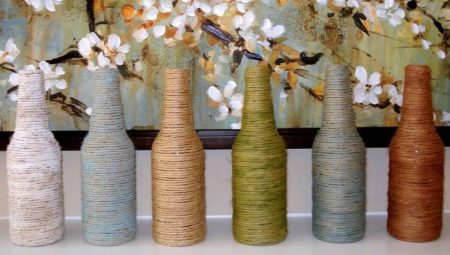
If the old vase is tired or does not look so attractive, you should not get rid of it as an unnecessary thing. It is better to think about how to decorate a vase at home with your own hands.



Decorating with fabric and ribbons
An interesting option is to sew a cover on the vase. Removable options are good because at any time the vase can be returned to its previous appearance. The cover may be seasonal. From fabric with a winter print or mood - New Year, from fabric with spring flowering - March, etc.
What other options for decorating a vase with fabric are there:
- Wrapping. The decorative winding will be fixed at the end of the process, while you can make waves, folds, and other effects. Usually, this option is complemented by other decor, for example, beads and ribbons.
- Soaking the fabric in glue. The fabric needs to be literally redeemed in an adhesive composition, and then wrap the bottle with it. Then glue seashells and other marine-themed elements to the dried surface, and then paint the vase blue. The makeover in a nautical style will be successful. This can be done with both floor and table vases.
- Lace "outfit". You can also sew a cover for a vase from lace, but not removable. It will be finished right on the glass product, narrowed to the neck, and hemmed in the same place. The neck itself can be tied in several rows with braid or thin satin ribbons, the ends of which are left rather large.



A very beautiful combination for a vase, which is also available for making at home - burlap and lace. You can take an ordinary transparent glass jar and wrap it with a strip of burlap about a third or a little more. Secure the last one. And on top, start up the lace row.The third layer will be jute rope, which will be tied with a bow. A beautiful spring vase is made from the most ordinary jar with your own hands.
You can even get a decor from ribbons in a few minutes. A real narrow vase will do, but there is another option, for example, find three beautifully shaped bottles, remove the labels, and wash to a shine. Each bottle will contain a flower. All containers are spirally tied with a not very thick satin ribbon. Further, improvised vases are put together and tied with a thicker ribbon of a different color, only in one area.
Alternatively, you can take two bottles and one glass, which will be lower than two bottles.



Decoration with natural materials
There will be even more options here. For example, "clothes" for a vase in the form of aligned twigs will look beautiful. You need to find branches of approximately the same thickness, dry them, cut them so that they are equal in length. Not necessarily millimeter to millimeter, but without large differences. Next, these twigs are glued to the vase with a glue gun - just a fence around the vase. All that remains is to tie it in the middle with twine, to make a bow. Sometimes the branches are painted, but this is not necessary.
Instead of twigs, you can use cinnamon sticks, then you can not only decorate the vase, but also make it an aroma decor. A large, wide and not very high vase can be pasted over with cones. The cones will have to be trimmed, because they should adhere to the surface with an even edge. Sometimes a vase with cones is varnished, but you can do without it.
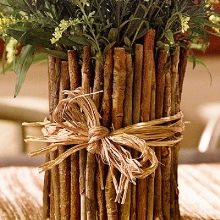


What other options are there:
- coffee beans - methodically glue grain by grain;
- beans and lentils, pumpkin seeds - the same story as with coffee;
- seashells - fit perfectly with their hollow side on the base, the vase will become a good memory of a seaside holiday;
- thuja twigs and the like - only they need to be fixed not on the original basis, but first, wrap the vase with twine or twine, around the entire perimeter.
For decoration, you can use moss, acorns, dried plants, tree bark - which will tell your fantasy. Such vases are especially good for summer and autumn bouquets, which, due to the nature of the season, will probably appear in the house more often.


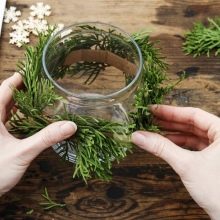
New Year's decor
This theme gives rise to even more beautiful ideas. There are ten great solutions to consider that are not so hard to repeat.
- No review can do without this option. It is enough to take a transparent vase and fit a small garland and several Christmas balls into it. True, the vase will no longer be utilitarian, but the decorative function will be at its best.

- Continuing the theme: the vase can be filled with cones painted in bright (with shine) colors, and again with Christmas balls, and also with coarse salt, which will play the role of snow. Very fast, but definitely beautiful.

- Vases can be tinted with glue using the spray method. And then also decorate with ready-made New Year's details like snowflakes. Again, a regular glass jar can be used in place of a vase.

- Wine bottles turn into chic snow vases, and all thanks to white paint (gouache, acrylic) and coarse salt on PVA glue. A New Year's worthy homemade decoration.

- With spray paint, you can paint a vase red, and then make straps from velvet black paper and golden cardboard. They can be attached to the vase with glue. Guess the association with the Santa costume.

- Lovely, very cozy and home-made cases for vases can be knitted with your own hands. They can be made for bottles (which are easy to turn into vases in everyday life), but for other forms that are not so narrow, it will also not be difficult to knit such covers.

- Just white spray paint, plus a dark stripe and accent red snowflake. And 3 old bottles are transformed into modern New Year's vases.

- Pages of old books, newspapers, as well as sheet music are perfect for such a decor.And you will also need ready-made plastic snowflakes, twine and some kind of decorative element (acorns, rhinestones, buttons, beads). In each such vase, even if it is very narrow, at least one spruce twig will definitely enter.

- Burlap, twine, acorns and a small fragment of a spruce twig are all you need to turn the most inconspicuous vase into a cozy and warm New Year's decor.

- However, you can trust the burlap completely and wrap the whole vase with it. A modest rope with a bow on the side - and a container for branches with snow-covered cones is ready.
As simple as possible, but the New Year's spirit immediately penetrates the house, as soon as such vases appear on the table, shelf or windowsill.

More ideas
The above is not all. To transform vases, different techniques are used, more complex ones, requiring knowledge or strict adherence to master classes.
Geometric patterns
For them to appear on the vase, you need masking tape. They will be sequentially glued to places that should not be painted over. And he will also allow you to do this so that the places are strict in their lines. Then the adhesive tape will peel off and it will take another place, etc. The decoration usually takes place with acrylic paints.
There is another option: geometric shapes are cut out of self-adhesive colored paper according to templates. And then they are glued to the vase in pre-designated places. It may well turn out a composition in the spirit of Kandinsky.



Pique technique
If in the previous version there were lines, here are points. For decoration, you will need a contour for glass and ceramics, cotton wool, alcohol. The latter is needed to degrease the work surface. The contour is applied with a dotted touch. A sketch of the painting can be made on paper in advance, and then attached to the vase from the inside, and painted, focusing on it.
Going beyond the line can be corrected until the contour is dry. The incorrect part can be removed with a napkin soaked in alcohol. An equal interval must be maintained between the points, unless, of course, the idea implies a different solution.

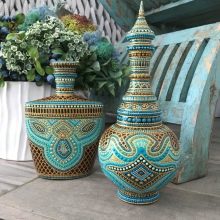
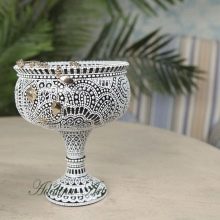
Stained glass painting
In addition to the same contour for glass and ceramics, you will also need special stained glass paints, as well as alcohol, cotton wool and a brush. The glass surface is first degreased, a pre-prepared sketch is placed inside (it can be found on the Internet and printed on a printer). Then you need to draw closed contours, wait until they dry - this can take a couple of hours. To speed up the process, you can use a hairdryer. Then the contour is to be filled.
This work can hardly be called creativity for beginners. Particularly diligent people can really figure it out and get a beautiful stained-glass painting on a vase the first time, but in most cases you have to practice. Even just remembering how to work with paints, brushes, color in general.



Beads
You can call it a mosaic based on a vase. Or an applique made of beads (beads). Not everyone can work impromptu, without a clear sketch. And it is also difficult to outline something on the glass so that you do not have to choose later. Therefore, a sketch printed (drawn) on paper helps out, which is inserted into a vase.
Half-beads are more suitable for decor: one side of them is as if cut off, it is flat. These adhere well to the base. Also, beads can be combined with lace, threads, buttons, it will also turn out beautifully.



Decoupage
For decoupage, the master will need either napkins with images, or special decoupage cards. Again, it's great if you have experience and decoupage is already familiar, it was used on something simpler. But you can take a chance, try and do it successfully and without experience.
The process of decoupage a vase with napkins looks like this:
- The white underlayer of the napkin is separated from the color one. The desired fragment is cut out of the colored one with scissors.
- The surface of the vase (cans, bottles) is lubricated with PVA glue.
- The cut fragment is applied with the pale side over the cellophane file.A little water is poured over the file.
- The picture must be straightened carefully, without damaging it. The water must be drained very carefully. "Wrinkles" should not appear on the napkin at this time.
- The file with the applique is fixed on the place smeared with glue. The drawing must be smoothed out with your fingers, right through the file. This removes air bubbles.
- Then the file can be removed, the picture can be smeared with a brush dipped in PVA. The glue, by the way, must be mixed halfway with water.
- The work dries up, after which it can be covered with a layer of varnish.
Decoupage is a subtle technique, but the result is elegant, close to professional decoration.



Marbled
In addition to a glass vase, you will need several paints of similar tones. At the bottom of the vase, you need to pour a little from each jar of paint. After that, the vase must be turned over slowly, directing it with its neck down. There is no need to rush, otherwise the paint will not stick to the glass. There is no need to add water. Each additional addition of paint implies an increase in its amount.
The vase needs to be scrolled until its entire surface is in the paint layer. At the end of the work, you just need to put the vase upside down on a paper towel so that excess paint drips from the container. When it is drained, the vase is to be laid on its side. It needs to dry. This can take up to two days.
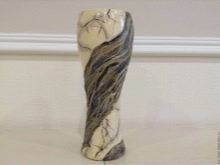


With sequins
The fastest and easiest way to decorate a vase in this way is to take a hairspray with glitter and spray it heartily onto a glass vase. Only after that will you have to properly ventilate the room. But this method is not the only one. You can coat a vase with PVA, and then generously sprinkle sparkles on it, and not even of the same color, but of different ones.
You can add glitter to gouache or acrylic paints and simply paint the vase in free style. Each method is available to everyone; special skills are not needed here. Subsequently, it will be much more pleasant to put flowers in your own transformed container.



Ideas are everywhere, you can find them in things that don't look artistic at all. For example, take children's tights with a cute print (color, pattern), cut them off and put them on a vase. Sew and fasten in the right places. To remove the cut from the field of view, at this place you can tie a ribbon or string, thick threads, etc.
Cool finds and their successful implementation!



For information on how to decorate a vase with your own hands at home, see the next video.








